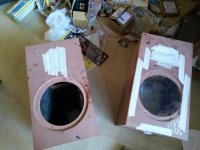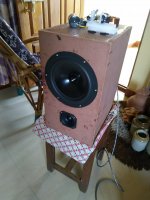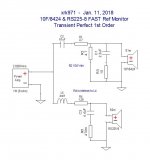My hearing drops off pretty much above 16kHz so what comes out of the 10F is very enjoyable and not lacking any sizzle to me. For me to hear “air” or “sizzle” from a full range or tweeter means it has to be unnaturally producing some +5dB or more bumps or peaks in the 5kHz to 12kHz range. This can be achieved when using less than flat drivers like the PS95-8 or the Alpine OEM Jeep Wrangler fullrange. These drivers sound lively and “exciting” - but they do not measure flat. So you could use it for entertainment and that’s fine. However, it would not be a “monitor” anymore. Such exciting to hear drivers will have a problem being able to play all genres equally well. That’s where the beauty of a flat “monitor” response comes in.
But this is entertainment and we can tune/tweak our speakers to whatever we like. The base configuration of the 10F/RS225 with the prescribed crossover is guaranteed to provide a flat (+/-2.5dB from 50Hz to 18kHz) and probably much lower with a properly adjusted TL.
But this is entertainment and we can tune/tweak our speakers to whatever we like. The base configuration of the 10F/RS225 with the prescribed crossover is guaranteed to provide a flat (+/-2.5dB from 50Hz to 18kHz) and probably much lower with a properly adjusted TL.
This little TB tweeter might fit.
13-1761S - 13mm Tiny Tweeter - TB SPEAKER CO., LTD.
Tang Band 13-1761S 1/2" Silk Dome Tweeter Pair
[url]https://www.parts-express.com/tang-band-w3-1723sa-3-coaxial-midrange--264-827
Hi, I believe those little Tang Band tweets were once incorporated in a small 3" coaxial model which is now defunct. I have a pair I was planning to use in a portable speaker, but ended up using a mini AMT.
Hi StudioMic.
Like Norman said, if you were to try and preserve time alignment, the Mini AMT would probably have to be pushed deeper into the cone. Or you could forego the coaxial idea and mount the tweeter down below the midwoofer, increasing distance to the listener the same way X has already done with the midwoofer itself in this design. Maybe a dome's dispersion would better accomodate that trick... I have been playing with the MiniAMT in XSim (thinking about mating it to ND90-8 in a totally different speaker) and may try routing a crude waveguide in my baffles to push the tweeter backwards.
Like Norman said, if you were to try and preserve time alignment, the Mini AMT would probably have to be pushed deeper into the cone. Or you could forego the coaxial idea and mount the tweeter down below the midwoofer, increasing distance to the listener the same way X has already done with the midwoofer itself in this design. Maybe a dome's dispersion would better accomodate that trick... I have been playing with the MiniAMT in XSim (thinking about mating it to ND90-8 in a totally different speaker) and may try routing a crude waveguide in my baffles to push the tweeter backwards.
Last edited:
I agree that first thing to try is to stick it on the baffle below the woofer and above the full range.
To get 3in of setback would be a pretty deep waveguide. Deep waveguides are tricky as there are always going to be wall interactions and cancellation dips as I am finding out by putting a RAAL tweeter at the throat of a 7.5in deep tractrix horn fitted with a pair of 3FE22’s for midrange injection near the throat.
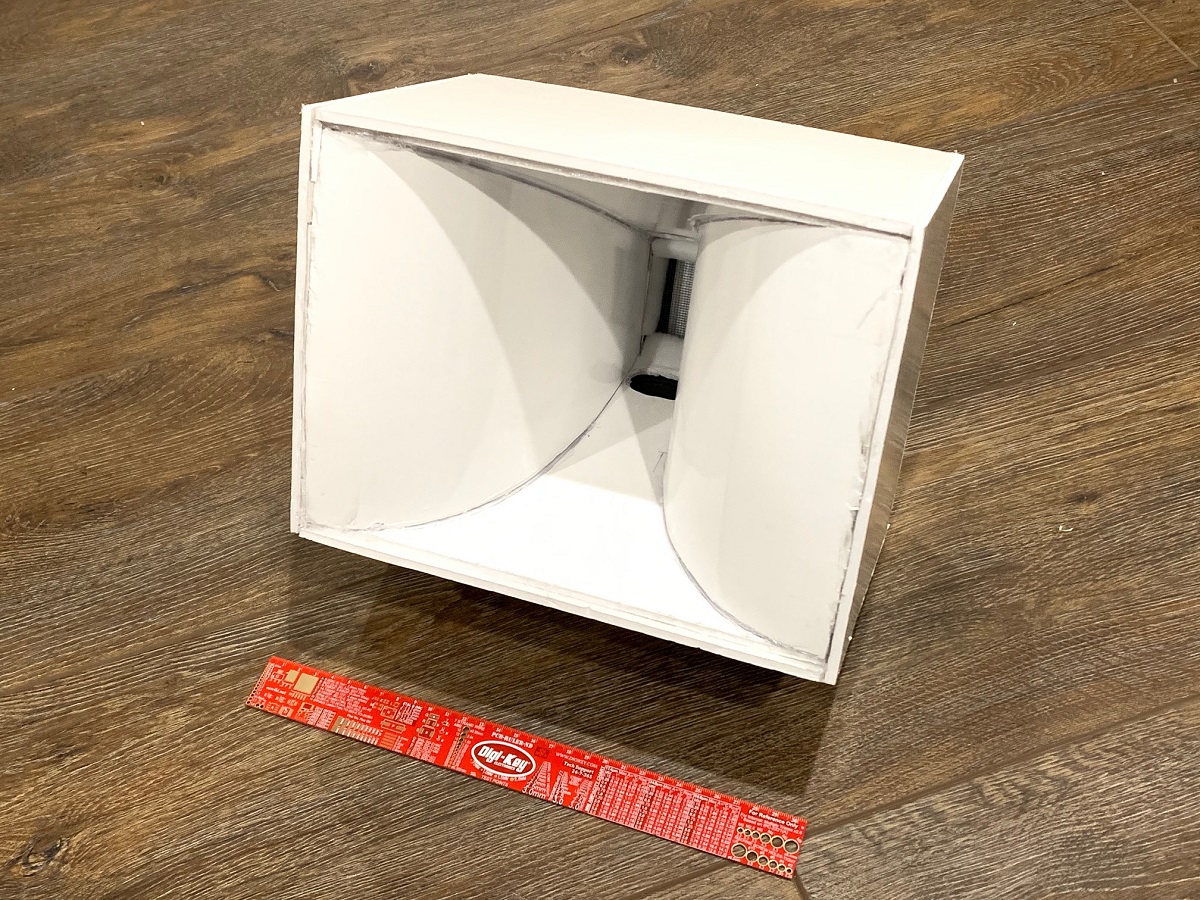
Nano-Trynergy - a Compact Tractrix RAAL Ribbon Point-Source Horn
You can see what I mean by dips near 5 and 9kHz.
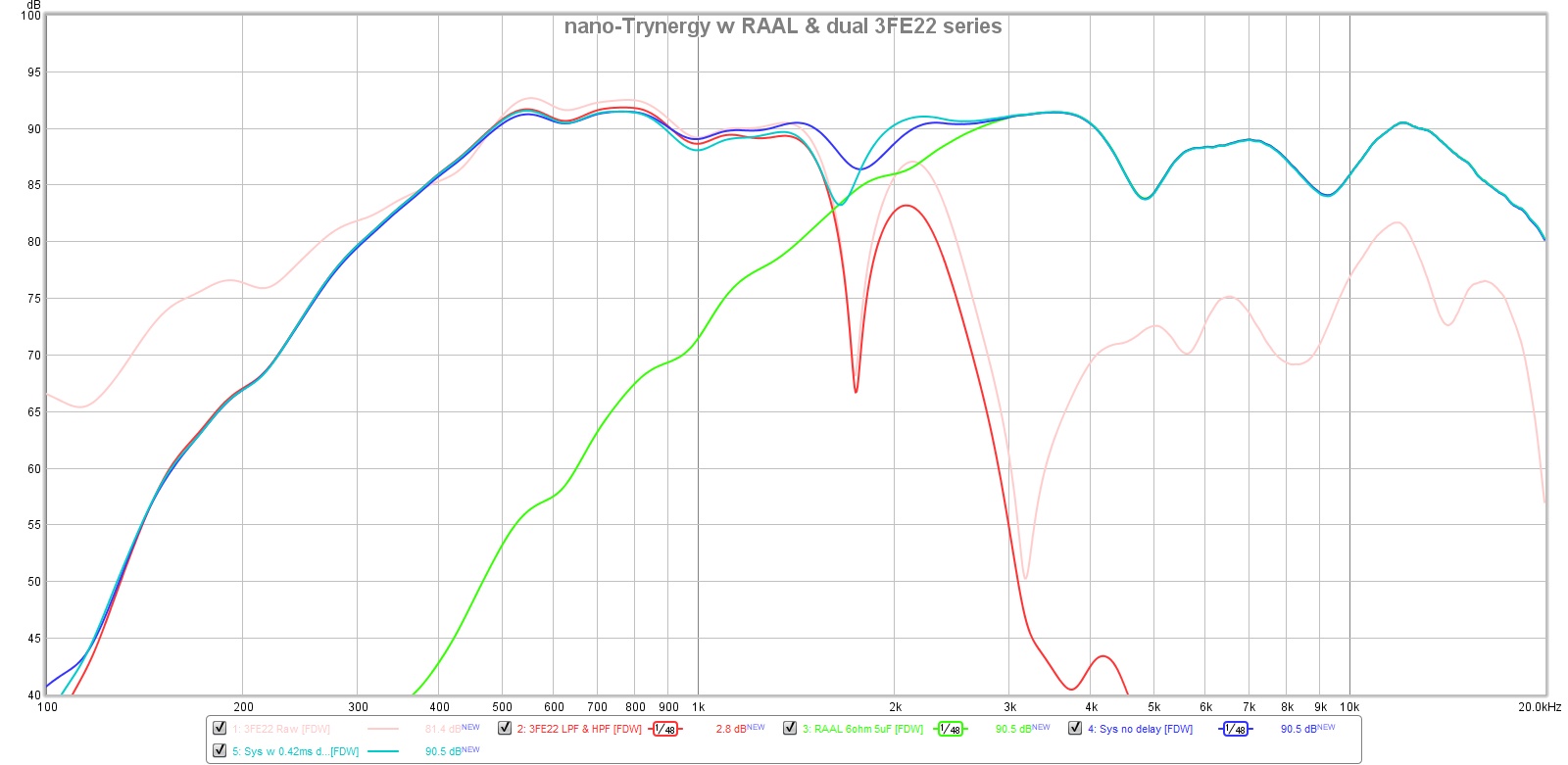
To get 3in of setback would be a pretty deep waveguide. Deep waveguides are tricky as there are always going to be wall interactions and cancellation dips as I am finding out by putting a RAAL tweeter at the throat of a 7.5in deep tractrix horn fitted with a pair of 3FE22’s for midrange injection near the throat.
Nano-Trynergy - a Compact Tractrix RAAL Ribbon Point-Source Horn
You can see what I mean by dips near 5 and 9kHz.
Weird dips.
I wouldn't expect that if there was a compression driver round throat on that shaped horn.
And the horn size seems bigger than a standing wave throat to mouth, across width, or across height.
I think those are from the rectangle slotted throat, but there are others who know far more than i do who can chime in on multi-way forum here that can tell you why
I wouldn't expect that if there was a compression driver round throat on that shaped horn.
And the horn size seems bigger than a standing wave throat to mouth, across width, or across height.
I think those are from the rectangle slotted throat, but there are others who know far more than i do who can chime in on multi-way forum here that can tell you why
Last edited:
I already did the analysis of the dip locations and they pretty much match the fact that there are 4 plane/plane walls at about 45mm spacing and 75mm spacing around the injection ports. Th dips in the tweeter correspond to the half distance from the middle of the RAAL membrane to the two different walls. I think the tractrix has a problem in that the first part of the horn has very little expansion and is like a straight duct - and this is a prime target for cancellation dips. If I redid this with a 90deg flat wall horn, I think it will be better,
So my long running build is nearing completion.Or so i like to think  .
.
Im running the TC9FD18-08 for the full range,and powered by a Gmarsh Wiener TPA3118 amp.Its all the power I need to listen at comfortable volumes.I also did manage to put together The Papa's Korg B1,so am using it as a pre amp .
Many thanks to fellow member Sadik for giving me the flatpack and helping me achieve this build!
I still need to finish the cabinets and give them a final look.

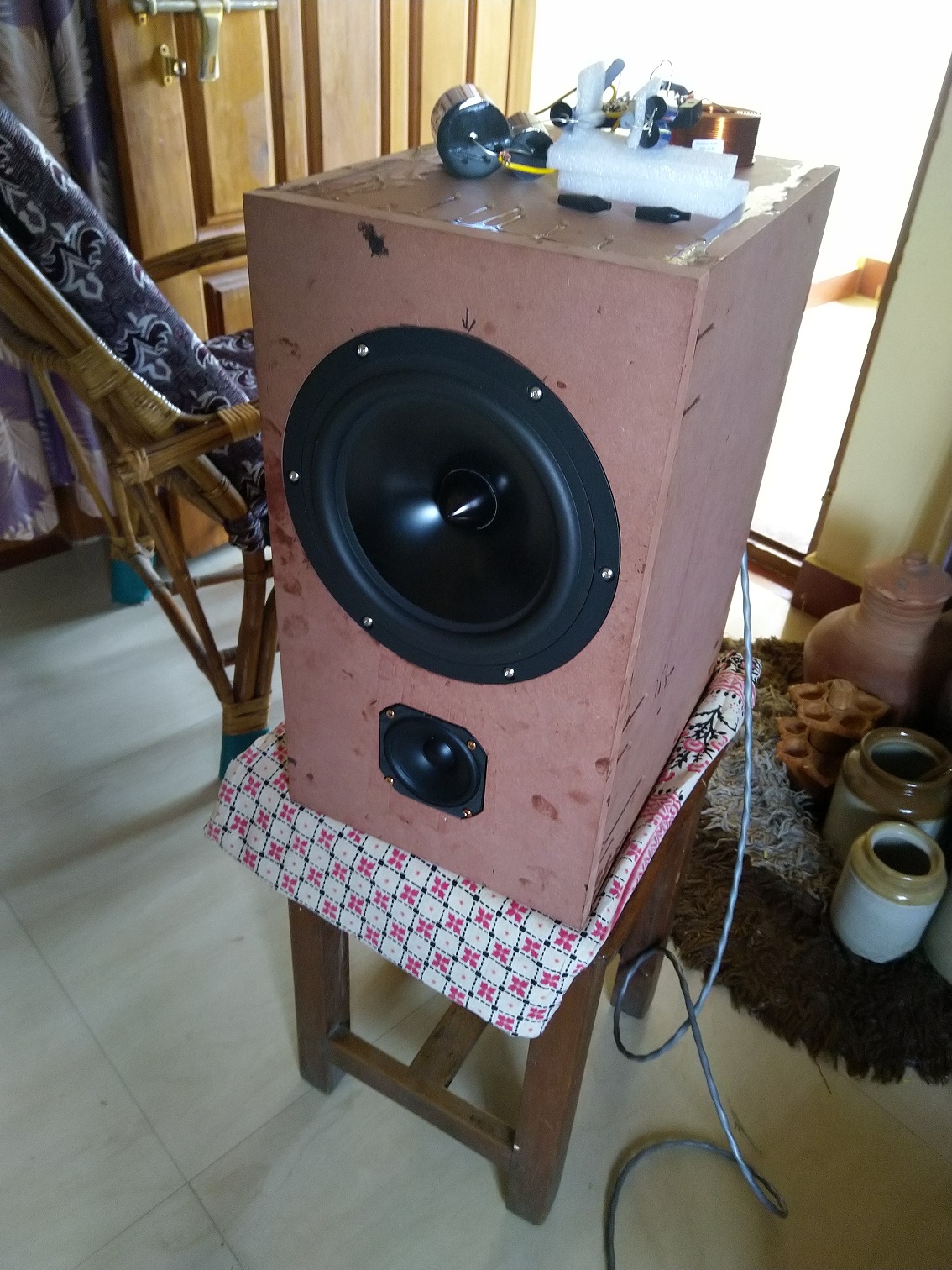
All the interior walls are lined with butyl rubber sheets,including the exterior of the cone.Also,the interior of the cabinets have eggshell foam on all surfaces.For stuffing,I have used polyfill from pillows.The cone is stuffed progressively,though not heavily stuffed.Same for the main cabinet,though I have packed polyfill around the cone.Behind the woofer,I have lightly placed stuffing,not heavily packed.
Listening impressions-I played some Indian classical music and it was great!Especially for male vocals.The played some instrumental music,mostly guitar and the RS-225 was really making its presence felt.
Then,I put some boom-tizz music (all instrumental video game sound tracks) and I felt the bass was too boomy. The mids and highs suppressed.
Now,the schematics are as given here,and as advised,I have tried reducing the value of R1 to 2.2 OHM,then 1.1 Ohm and finally removed R1 from the circuit totally.
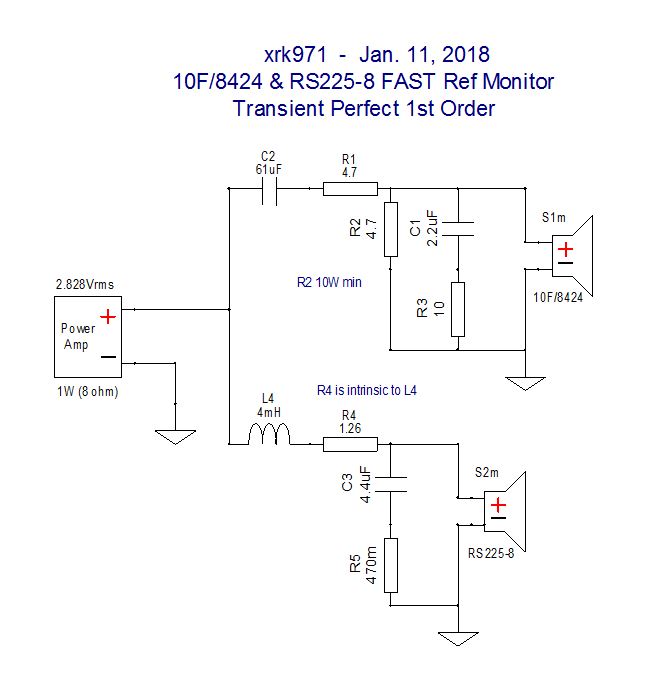
I feel the Highs and mids are back after removing R1,but I still am not satisfied with what I'm hearing.Perhaps its a effect of listening too much with headphones on?maybe. The speakers are far away from any walls and I have removed the carpeting so I can do woodwork and glueing without messing things up too much.
I still have to do some more trials
1.Adjust the stuffing in the cone,as I read improper stuffing(more stuffing) will suppress the mids. I dont think I have overstuffed the cone,though I will try and find out for different levels of stuffing.
2.Line the interior of the cone for a inch or two with butyl rubber pieces.
3.Play with the stuffing behind the woofer by increasing and decreasing the stuffing to various intensities
4.Check the phase of my speakers?
5.Play with bypassing C1 with higher quality caps.I have used Jantzen's cross cap,total value 61uf (I remember reading some time ago on this improving the sound)
6.Maybe try out a nice class AB amp,with a bit more oomph.IMO,the TPA 3118 is in the best possible board that can be built and no expense has been spared for parts selection and quality of layout.I dont need more power as I am not turning the volume pot all the way yet and the speakers are playing as loud as I could personally tolerate.
7.Buy a measurement mic and perhaps even a DATS kit,to evaluate my changes(though it will be a expensive investment after the customs chaps have their cut)
8.Change the value of R2 to something else?How do I go about this?
Im running the TC9FD18-08 for the full range,and powered by a Gmarsh Wiener TPA3118 amp.Its all the power I need to listen at comfortable volumes.I also did manage to put together The Papa's Korg B1,so am using it as a pre amp .
Many thanks to fellow member Sadik for giving me the flatpack and helping me achieve this build!
I still need to finish the cabinets and give them a final look.
All the interior walls are lined with butyl rubber sheets,including the exterior of the cone.Also,the interior of the cabinets have eggshell foam on all surfaces.For stuffing,I have used polyfill from pillows.The cone is stuffed progressively,though not heavily stuffed.Same for the main cabinet,though I have packed polyfill around the cone.Behind the woofer,I have lightly placed stuffing,not heavily packed.
Listening impressions-I played some Indian classical music and it was great!Especially for male vocals.The played some instrumental music,mostly guitar and the RS-225 was really making its presence felt.
Then,I put some boom-tizz music (all instrumental video game sound tracks) and I felt the bass was too boomy. The mids and highs suppressed.
Now,the schematics are as given here,and as advised,I have tried reducing the value of R1 to 2.2 OHM,then 1.1 Ohm and finally removed R1 from the circuit totally.
I feel the Highs and mids are back after removing R1,but I still am not satisfied with what I'm hearing.Perhaps its a effect of listening too much with headphones on?maybe. The speakers are far away from any walls and I have removed the carpeting so I can do woodwork and glueing without messing things up too much.
I still have to do some more trials
1.Adjust the stuffing in the cone,as I read improper stuffing(more stuffing) will suppress the mids. I dont think I have overstuffed the cone,though I will try and find out for different levels of stuffing.
2.Line the interior of the cone for a inch or two with butyl rubber pieces.
3.Play with the stuffing behind the woofer by increasing and decreasing the stuffing to various intensities
4.Check the phase of my speakers?
5.Play with bypassing C1 with higher quality caps.I have used Jantzen's cross cap,total value 61uf (I remember reading some time ago on this improving the sound)
6.Maybe try out a nice class AB amp,with a bit more oomph.IMO,the TPA 3118 is in the best possible board that can be built and no expense has been spared for parts selection and quality of layout.I dont need more power as I am not turning the volume pot all the way yet and the speakers are playing as loud as I could personally tolerate.
7.Buy a measurement mic and perhaps even a DATS kit,to evaluate my changes(though it will be a expensive investment after the customs chaps have their cut)
8.Change the value of R2 to something else?How do I go about this?
Attachments
I'm surprised that you would find a monitor size version of the FAST "boomy". I'm getting more bass than I want but it's the same setup on a wood transition line speaker. Everything you described seems fine.
Did you line the inside of the cone with an open cell foam. We used melamine sponges cut in half. Seems like a good thin lining on the inside of the cone would be important. Is the cone sealed good? These things don't seem like they would make it "boomy" but they are important. The woofer could be driving your full range a little and screwing it up if the cone isn't sealed.
Did you line the inside of the cone with an open cell foam. We used melamine sponges cut in half. Seems like a good thin lining on the inside of the cone would be important. Is the cone sealed good? These things don't seem like they would make it "boomy" but they are important. The woofer could be driving your full range a little and screwing it up if the cone isn't sealed.
Woofer driving the full range.. I don't think so. Or atleast I hope it's not. I had checked the cones thoroughly before closing up the box.
Yes, I did read about lining the inside of the cone with melamine foam. But, that particular type of foam is not available locally so I need to search online for magic eraser.
Yes, I did read about lining the inside of the cone with melamine foam. But, that particular type of foam is not available locally so I need to search online for magic eraser.
Interesting. I'll try it out!Pay no attention to the pot position on your amp.
You can compare response changes with pink noise, REW/other apps, and any computer/phone mic, even w/o calibrated flat response you can see changes.
Very helpful.
Last edited:
Dr. Wow Magic Sponge
Thanks for the reminder, I just ordered these.
I had some on order from eBay/China but they are way late. XRK kindly sent me the ones for the test speaker, but we have 5 FAST TLs in the wood-shop right now.
Thanks for the reminder, I just ordered these.
I had some on order from eBay/China but they are way late. XRK kindly sent me the ones for the test speaker, but we have 5 FAST TLs in the wood-shop right now.
Isn't the problem experienced the difference in sensitivity between a Scan Speak 10F and a Vifa/Peerless TC9? I'd expect the TC9 needs less padding down than the 10F.
That's what R1 & R2 do I assume. Let X shine his light on the subject, what needs to be changed for the TC9.
That's what R1 & R2 do I assume. Let X shine his light on the subject, what needs to be changed for the TC9.
I feel the Highs and mids are back after removing R1,but I still am not satisfied with what I'm hearing.Perhaps its a effect of listening too much with headphones on?maybe. The speakers are far away from any walls and I have removed the carpeting so I can do woodwork and glueing without messing things up too much.
Try 2.2R for R1 and 10R for R2 with TC9. TC9 is 85dB and 10F is 87dB so you need less padding. You need to cut the TC9 by 3dB since bass is about 82.5db from RS225 after baffle step loss.
Nice work!
With the correct level adjustment between the full range and the woofer, you will have a seamless transition and it should not sound boomy. It is a sealed box with a nice slow rolloff so bass will be very articulate. When dialed in correctly, it is one of the best sounding speakers I have heard. It sounds better than $13k B&W 802D's, and that's not just my opinion - but opinion of an 802D owner who heard these for himself.
Last edited:
Dr. Wow Magic Sponge
Thanks for the reminder, I just ordered these.
I had some on order from eBay/China but they are way late. XRK kindly sent me the ones for the test speaker, but we have 5 FAST TLs in the wood-shop right now.
I can send you more for 5 more speakers.
Would anyone here sell flat packs ?
I would like a box for the 225 but the woofer mounted almost touching the top.
And a smaller box for the 10f (but the same width).
Routered out for air passages around driver would be nice too.
That way i can slide the 10f back to where my ears like it.
Xrk, the 4mh coil, does that give some baffle step ?
I would like a box for the 225 but the woofer mounted almost touching the top.
And a smaller box for the 10f (but the same width).
Routered out for air passages around driver would be nice too.
That way i can slide the 10f back to where my ears like it.
Xrk, the 4mh coil, does that give some baffle step ?
FAST TL PRODUCTION LINE
We will be ready with remaining five speakers in no time flat. I'm going to do the sound damping before the second side wall goes on. This should be a lot easier than reaching in around the cone. We have templates built for assembly and router work, so making these in the future will be a lot easier.



We will be ready with remaining five speakers in no time flat. I'm going to do the sound damping before the second side wall goes on. This should be a lot easier than reaching in around the cone. We have templates built for assembly and router work, so making these in the future will be a lot easier.



- Home
- Loudspeakers
- Full Range
- 10F/8424 & RS225-8 FAST / WAW Ref Monitor
